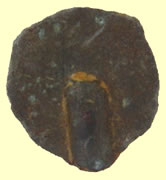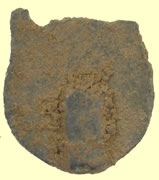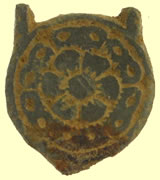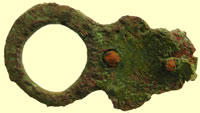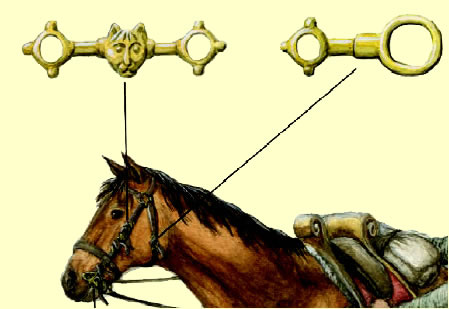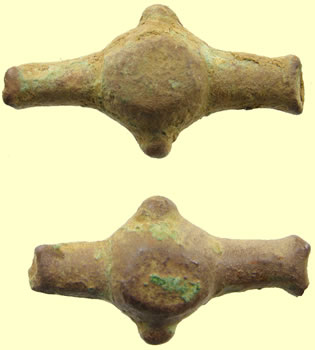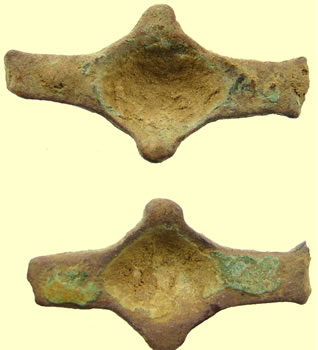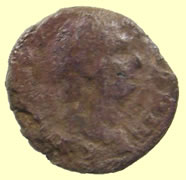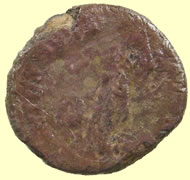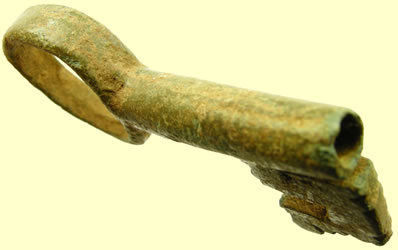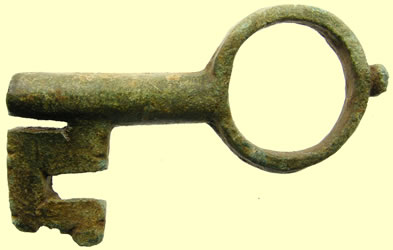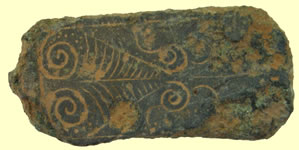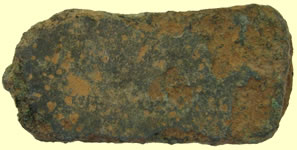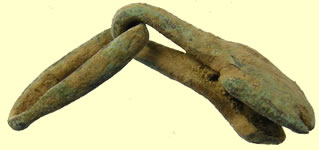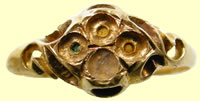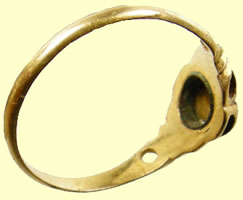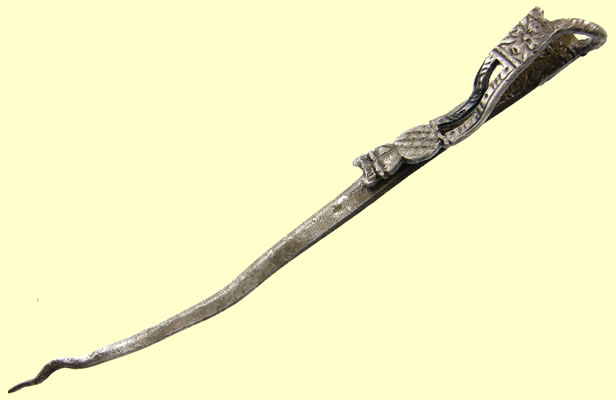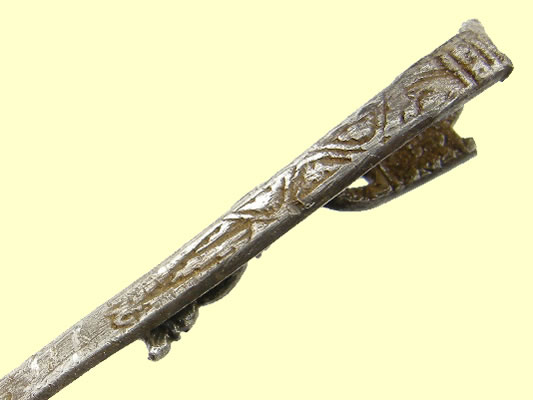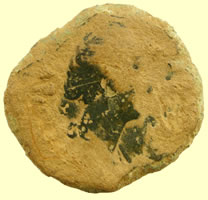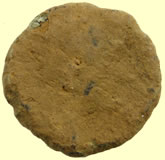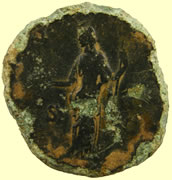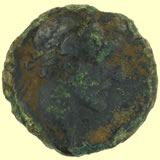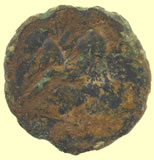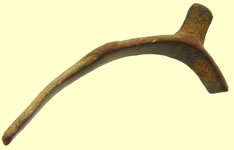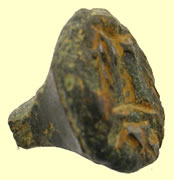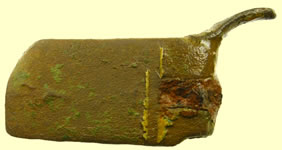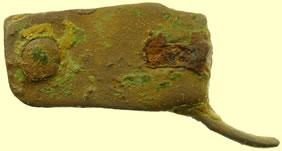

Metal detecting holidays in England with the World's most successful metal detecting club.
Twinned with Midwest Historical Research Society USA
Feb 2010 finds page
|
Large 11000 BC flint hand axe - 99mm L x 80mm W |
|||
Possible Romano/British silver handle - reported as treasure to Colchester museum 11.84g, 33.36mm w x 41.46mm H x 7.24mm T |
|||
Full size Roman stone phallic ornament, George III sixpence for size - 72.5 mm L x 30.71mm W
|
|||
Interesting group, but I'm afraid what they indicate is at very least a couple centuries occupation.
I'm thankful you're asking for guesses at this point - very little here I am feeling completely confident attributing to specific folks, but the general time-frames are not in question. I will try to fill-in details over the next couple days (I'm recovering from the flu and not spending as much time at my desk as I normally do.)
The one you describe as "Celtic" is most likely Spanish - "Romano-Celitberian" as they call them - segueing into Provincial issues - and is a "DIVVS" (deified) someone from the clear bit of counter-clockwise legend around 4:00-5:00. I'm guessing Augustus but it could be Julius, Agrippa, etc. Not earlier than late 1st century BC (c. 40 BC at the earliest) and not likely to be later than 25-35 or so AD when the Spanish Provincials dried up in favor of Imperial coin.
The one with the apparently severly advanced bronze disease pits in the obverse I can tell you is a "Caesar" - as in "crown prince", "emperor in training", "heir apparent", etc. The reverse type is PRINCIPI IVVENTVTIS - or some variant of the same - "Prince of Youth". I don't know, off the top of my head, which Caesar was portrayed with 4 standards and holding a scepter (that's unusual - typically it's only 1 or 2 standards, but this should work to our advantage, eventually), but I'm sure I can figure it out. It's unlikely to be earlier than Commodus (c. 160's) or later than Herrenius Etruscus (c. 250) If I read your metrics correctly, that one's an As
The one in the middle, of approximate sestertius weight with the gorgeous portrait, seems not to be Roman Imperial - at first glance, it seems to be Provincial, but since so far I can't read a single letter on obverse or reverse - I'd have to guess that one was supposed to be Caracalla, Geta, Philip II, or another of the baby-faced but bearded 3rd century folks. - Again, gussing only, c. 200-245 AD. The portrait style is just not correct for Roman Imperial of the era.
Mark
|
|||
c10thC Saxon strap terminal |
|||
 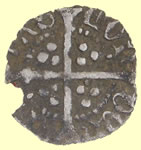 |
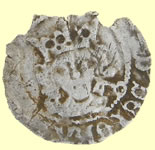 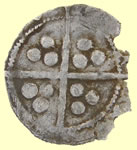 |
||
1413 -22 Henry V hammered silver halfpenny - broken annulets by crown - earl hair - Type 5 Obv HENRIC REX ANGL Rev CIVI/TAS/LON/DON - London mint 0.42g, 13.57mm |
Sede Vacante 1472-75 Edward IV hammered silver (Archiepiscopal issue) penny G & key by bust Reverse plain cross Obv EDWARD DI GRA REX ANGL - York mint |
||
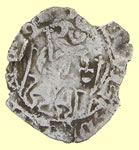 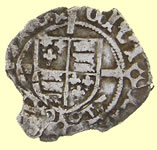 |
  |
||
1485 AD Henry VII Sovereign penny - York, Archbishop. Rotherham, keys below shield type |
Saxon key - pendant type |
||
|
|||
| 2- 16thC Tudor clothing fastener with religious inscription from different fields
IHS: dating from the 8th c., this is an abbreviation for "IHESUS," the way Christ's Name was spelled in the Middle Ages (despite popular belief, the monogram stands neither for "Iesus Hominum Salvator" --"Jesus Saviour of Men" -- nor for "In His Service.") Popularized by St. Bernardine of Siena, the monogram was later used by St. Ignatius of Loyola as a symbol for the Jesuit Order. The IHS monogram is an abbreviation or shortening of Jesus' name in Greek to the first three letters. Thus ΙΗΣΟΥΣ, ιησυς (iēsus, "Jesus"), is shortened to ΙΗΣ (iota-eta-sigma), sometimes transliterated into Latin or English characters as IHS or ΙΗC. The symbol is said to appear rarely in the catacombs, only in the catacomb of Priscilla and the atrium of the Capella Gr�ca (Greek Chapel).1 It was popularized in the fifteenth century, however, by Franciscan disciple Bernadine of Sienna as a symbol of peace. In 1541 St. Ignatius Loyola adopted the symbol with three nails below and surrounded by the sun as the seal of the Jesuit order. Contrary to some authors, the monogram originally stood for neither for Iesus Hominum Salvator ("Jesus Savior of Men") nor for "In His Service." Some attribute its origin to Constantine's vision, where he saw a cross with the inscription "In hoc signo vinces" ("in this sign you shall conquer,"2 which is abbreviated, according to them, as IHS. However, this seems to require a stretch, as do claims that it is really a pagan symbol. The simplest explanation, as an abbreviation of Jesus' name, is best.
16thC Tudor clothing fastener
|
|||
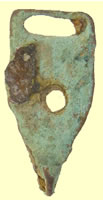 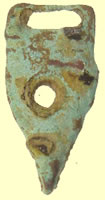 |
 |
||
C 10thC Saxon clothing fastener - single rivet fixing |
Medieval bronze beehive thimble |
||
 |
 |
  |
|
Saxon lead gaming piece |
Medieval lead hanging weight |
17thC mount with 2 integral lugs |
|
 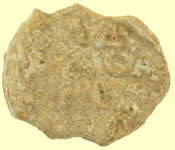 |
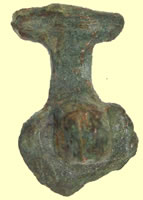 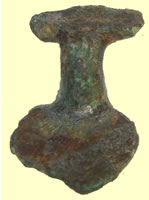 |
||
1776 Russian lead bale seal |
2nd C Roman knee brooch |
||
 |
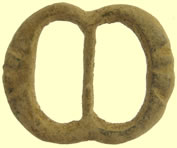 |
 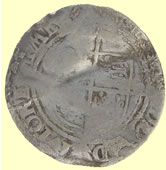 |
|
1550-1650 buckle |
1550-1650 buckle |
16thC Elizabeth 1st hammered silver groat |
|
  |
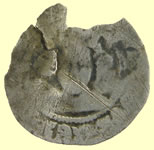 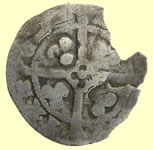 |
||
1731 French Louis XVIII 3 tour silver coin |
1422 Henry VI hammered silver penny - quatrefoil with pellet at centre reverse cross |
||
 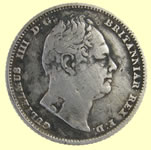 |
 |
||
1831 William IIII milled silver 6 pence |
Army fuseliers cap badge LF |
||
 |
 |
 |
|
19thC livery button |
19thC livery button |
19thC bone button |
|
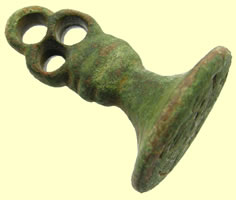  |
|||
Stunning 16thC seal matric - R H |
|||
 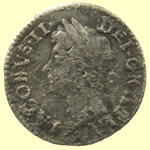 |
  |
||
1688 James II milled silver 2 pence |
1603 James 1st lead token |
||
  |
 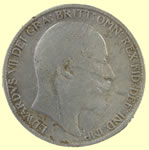 |
||
1247 Henry III hammered silver cut short cross half penny Obv * ON CA - Canterbury mint |
1907 Edward VII milled silver sixpence |
||
 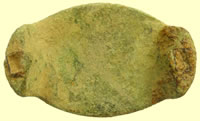 |
|
||
17thC decorated belt slide |
Roman latch key |
||
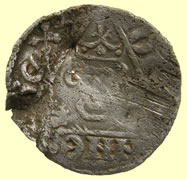 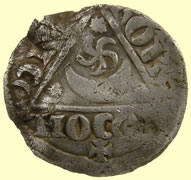 |
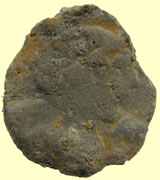  |
||
1209- 1216 John as King of ireland hammered silver penny- Rex coinage Obv IOHANNED(S)REX Rev DIVE - Dublin mint Moneyer ROBERD 17.84mm, 1.29g |
Very interesting Roman lead token sent off to Mark Lehmsn for his views - Potin ? |
||
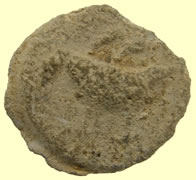 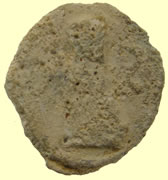 |
|
||
Roman lead token |
Saxon decorated strap guide - 2 rivet fixings |
||
 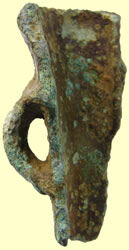  |
|||
1000 BC Bronze age socketed axe fragment
|
|||
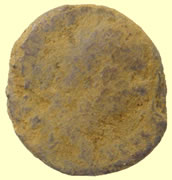 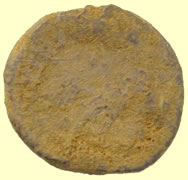 |
 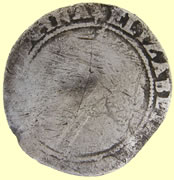 |
||
Roman silver coin - in the 'cooker' clean it |
1581 Elizabeth 1st hammered silver 6 pence |
||
 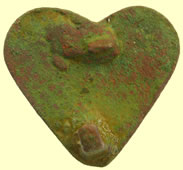 |
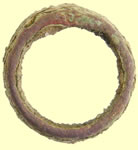 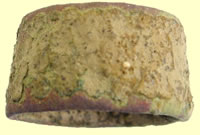 |
||
17thC mount with 2 integral lugs |
15thC open topped thimble |
||
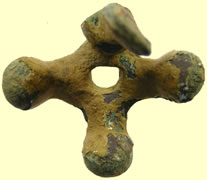 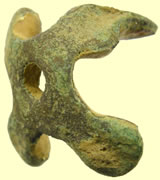 |
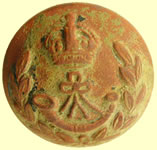 |
 |
|
Medieval gilded harness pendant |
Kings Royal rifle Corp 1881- 1958 |
1340 1450 Medieval buckle with composite plate |
|
|
|||
Interesting finds c10thC - 2 Saxon harness cheek pieces from the same field and they appear to be from the same maker |
|||
 |
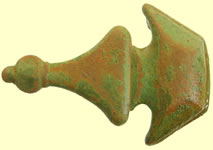 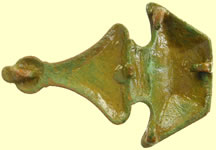 |
||
1550-1700 mount with 5 integral lugs |
|||
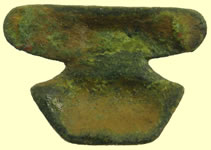 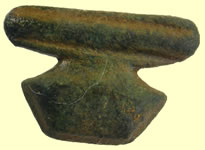 |
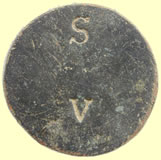 |
||
17thC mount with 2 integral lugs |
17thC 5 shilling silver bullion weight - 5 V |
||
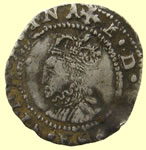 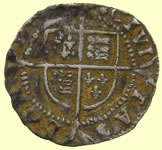 |
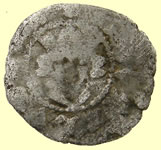 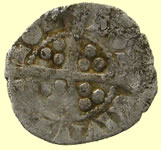 |
||
1560-61 Elizabeth 1st hammered silver penny - Cross Crosslet inital mark |
1279 Edward 1st hammered silver farthing 0.38g,11.76mm Rev CIVI/TAS/LON/CON London mint |
||
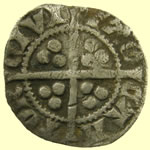  |
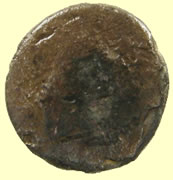 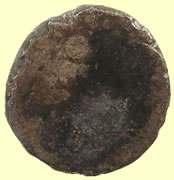 |
||
1341 Edward III hammewred silver florin penny Obv EDWAR ANGL DNS HYB Rev CIVI/TAS/CAN/TOR - Canterbury mint 1.26g, 18.59mm |
Well worn Roman BC period Republican silver coin - hopefully there is some detail under the crust after it is 'cooked' |
||
Roman 1st/2nd C silver coin as dug and 'cooking' to remove crust |
|||
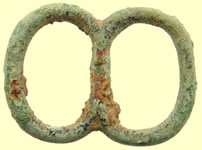 |
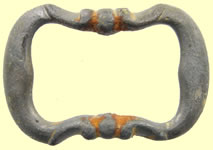 |
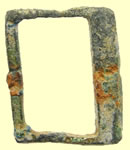 |
 |
1550-1650 buckle |
1660 - 1800 buckle |
1350- 1400 buckle |
1550-1650 buckle |
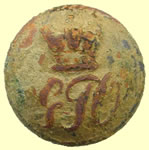 |
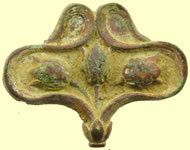 |
 |
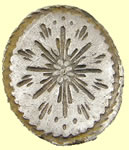 |
General post office button |
Victorian mount |
19thC livery button |
Georgian cufflink |
 |
 |
 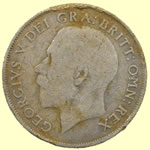 |
|
17thC mount with 2 integral lugs |
19thC buckle |
1921 George V milled silver shilling |
|
|
|||
1726 gold mourning ring - Legend with black enamel reads TIM COOKE 1726 AGE 73 2.07g, 20.34mm dia |
|||
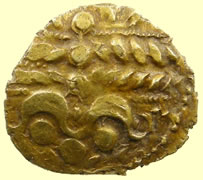 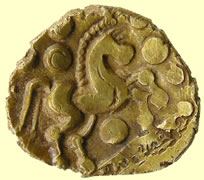 |
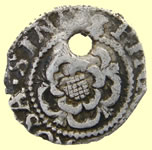 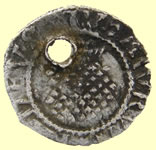 |
||
Celtic gold qtr stater 13.56,1.29mm - not sure of tribe yet, sent to Celtic coin index for recording and ID 'Your latest quarter is the 'Heybridge Horse' type, not in VA or any of the other catalogues as you say. There are eight others known of the standard type with a pellet below the horse plus a unique variety with a spiral below. All the known finds are from Essex so it's almost certainly a Trinovantian issue that probably circulated alongside late Whaddon Chase staters of VA 1498-1502 type to judge from the very similar horse; datewise probably struck somewhere in the 40s BC. |
1603 James 1st hammered silver penny |
||
|
|||
Huge medieval key 76.34mm |
|||
 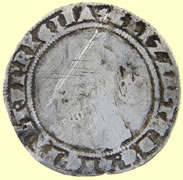 |
  |
||
1573 Elizabeth hammered silver sixpence |
1841 Victoria milled silver sixpence |
||
 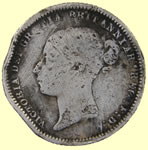 |
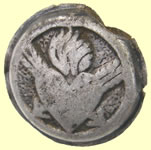 |
||
1872 Victorian milled silver sixpence |
17thC Charles II silver button - reported as treasure to Colchester museum |
||
|
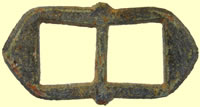 |
||
Medieval decorated strap end |
1550-1650 buckle |
||
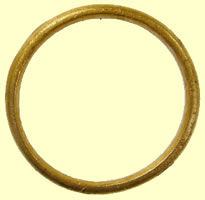 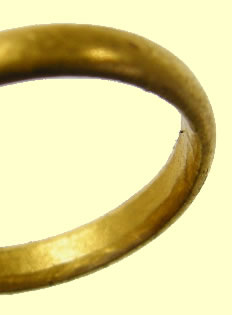 |
|||
Medieval gold finger ring - reported as treasure to Colchester museum 1.71g,15.40g |
|||
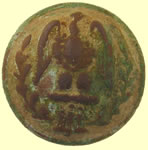 |
 |
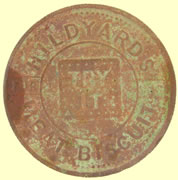 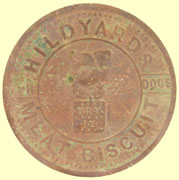 |
|
19thC Essex regiment button |
1876-1894 Honour; if the head of a "blackamoor" or Moor, refers to deeds of prowess in the Crusades Livery button Firmin & Sons Ld |
20thC token HILDYARDS MEAT BISCUIT FOR DOGS |
|
  |
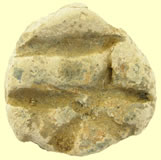 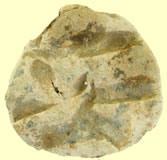 |
||
17thC Horse finial |
Saxon lead pendant - single loop hole |
||
  |
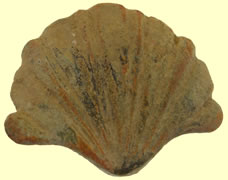 |
||
17thC golded mount with 2 integral lugs |
Knife blade guard |
||
 |
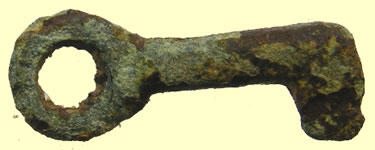 |
||
Roman helmet trim |
Medieval casket key |
||
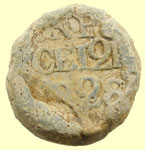 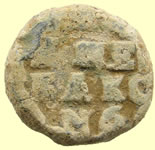 |
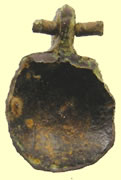 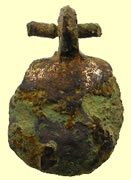 |
||
1828 Russian lead bale seal |
Medieval gilded harness pendant |
||
 |
 |
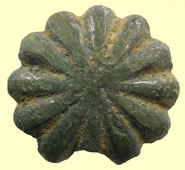 |
|
19thC livery button |
19thC livery button |
Roman Baldric mount |
|
|
|||
Lead trade weights- Roman to medieval |
|||
 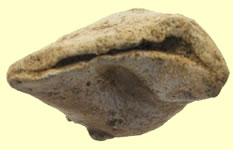 |
|
||
1640 lead Civil war period lead gunpowder measure |
Roman tie loop - 2 rivet fixings |
||
  |
|
||
17thC mount with 2 integral lugs |
16thC sword belt fitting |
||
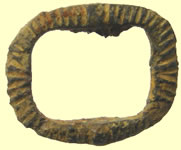 |
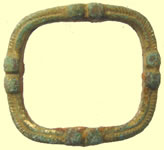 |
  |
|
Georgian buckle
|
Georgian buckle |
1247 Henry III hammerted silver shortcross half penny Obv HENRICVS REX Rev **N.ON.C( - Canterbury mint |
|
 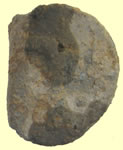 |
 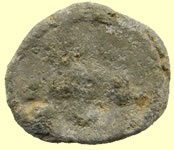 |
||
17thC lead token |
Roman lead token
|
||
 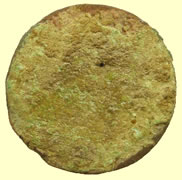 |
|||
1667 'His Halfpenny'hammered copper trade farthing |
|||
Boston Beau finds gold
|
|||
16th/17thC gold ring - no hall marks 1.75g, 18.51mm dia - reported to Colchester museum as treasure |
|||
 |
 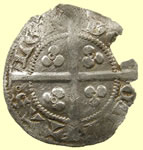 |
||
2ndC Roman fibular brooch - casting flaw |
1351 Edward III Pre treaty Series A - hammered silver penny Annulet to centre of 3 pellets in each qtr of reverse Obv EDWARDVS REX Rev CIVI/TAS/LON/DON |
||
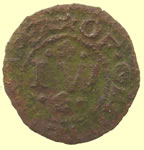 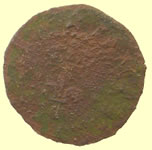 |
|
||
17thC Joseph Wolford, Mercers of Toppesfield Essex hammered copper trade farthing Norweb Fig 1407 Part II |
Ancient gold ingot - 0.76g, 10.76mm long Chunk of ancient gold - reported to Colchester museum as treasure |
||
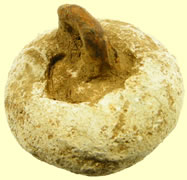 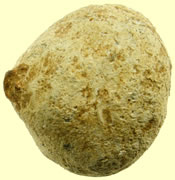 |
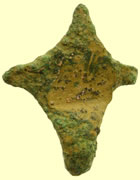  |
||
Medieval lead hanging weight |
C10thC Saxon brooch |
||
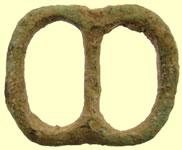 |
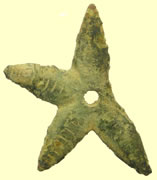 |
  |
|
1550-1650 buckle |
Medieval decorated spur rowel |
Mid 4thC Barbarious radiate Romn bronze coin |
|
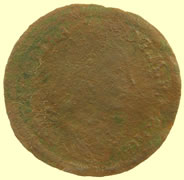 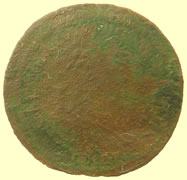 |
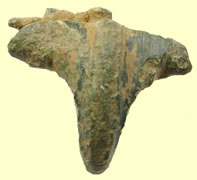 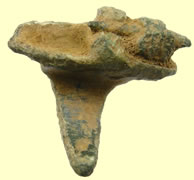 |
||
17thC Continental jetton - not checked ref books yet |
2ndC Roman fibular brooch |
||
  |
  |
||
Very interesting gilded Roman bronze piece - one for the museum |
19thC silver signet ring - Birmingham hall mark - worn date letter 4.60g Maker NBs |
||
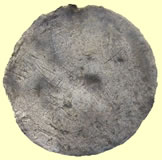 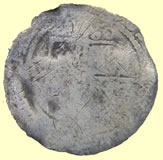 |
  |
||
1560 Elizabeth 1st hammered silver half groat |
1485-7 Henry VII hammered silver groat |
||
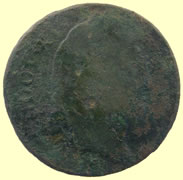 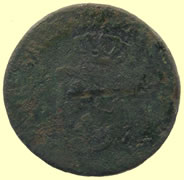 |
  |
||
18thC Continental copper coin |
Interesting 18thC Conder token - not one I know so have to do some more research Obv - Man using a weaving loom |
||
  |
 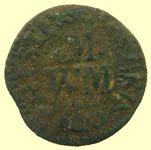 |
||
17thC belt slide |
17thC William Moore , bays maker of Colchester Essex hammered copper trade farthing Norweb Fig 1202 Part II |
||
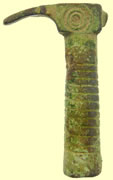 |
 |
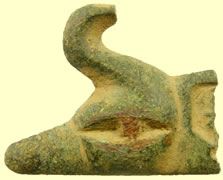  |
|
Georgian hammer type pipe tamper |
16thC Tudor clothing fastener |
Medieval mount - rivet fixing |
|
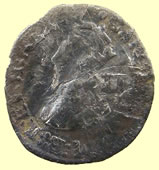 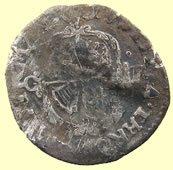 |
|
||
1634 Charles 1st hammered silver half groat - Group D CR by shield Aberystwyth mint - single pellet |
Interetsing decorated Roman bronze piece - implement handle ? |
||
|
|||
Stunning 16th/17thC decorated silver bodkin needle - reported as treasure to Colchester museum 2.79g, 70.64mm L |
|||
 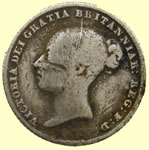 |
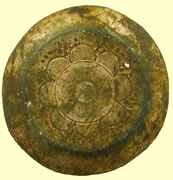 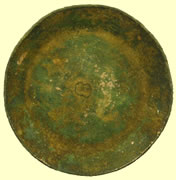 |
||
1844 Victoria milled silver sixpence |
Interesting gilded mount - one for the museum |
||
|
|||
Using the 'distilled water ' method to clean up two Roman bronze with detail - still soaking to remove the rest of the crud
The larger of the two is Faustina the Elder - wife of Antoninus Pius. She did her duty as a Roman matron and popped-out a lot of Imperial larvae, then (conveniently for him, it would seem - although we have no evidence of him taking any advantage of his most-eligible-bachelor status) she died in 141 AD, only 3 years after Antoninus donned the purple. Among her daughters was Faustina the Younger, wife of Antoninus' successor, Marcus Aurelius. This coin was part of the relatively huge posthumous coinage Antoninus minted in her honor throughout his long reign (138-161). The reverse shows Juno standing left, holding a patera and resting on a scepter.
The smaller piece, an As it would appear, is Antoninus Pius - other than what I think is a pair of legs - indicating a standing character of some sort - I'm afraid I can't make sense of the reverse from the photo - if it is cleaned any further, or you can get a photo which makes whatever detail there may be seem more clearly visible, I can give you at least a guess as to what the reverse type might be.
Mark
Antoninus Pius (138-161 AD) AE As, 26mm, 10.50gm, BRITANNIA COS III; SC (in ex). Britannia seated left on rock in attitude of dejection, chin propped on right hand and left hand resting on rock; in background, shield and vexillum. RIC II 934, SR 4296, VM 119.
These are not "rare", or even really scarce, but they tend to sell for much more than comparable contemporary pieces due to the Britannia reverse. This design was struck on all of Antoninus' AE denominations and the sestertii can be quite pricey - particularly if they're in nice condition.
There is also a Britannia reverse from Hadrian's "grand tour" series, but those are rare - and very expensive.
I'll get back to you when I've had a chance to analyze the photos you attached to today's mail.
Mark
Antoninus Pius (138-161 AD) AE As, 26mm, 10.50gm, BRITANNIA COS III; SC (in ex). Britannia seated left on rock in attitude of dejection, chin propped on right hand and left hand resting on rock; in background, shield and vexillum. RIC II 934, SR 4296, VM 119. These are not "rare", or even really scarce, but they tend to sell for much more than comparable contemporary pieces due to the Britannia reverse. This design was struck on all of Antoninus' AE denominations and the sestertii can be quite pricey - particularly if they're in nice condition.
There is also a Britannia reverse from Hadrian's "grand tour" series, but those are rare - and very expensive.
I'll get back to you when I've had a chance to analyze the photos you attached to today's mail.
Mark
|
|||
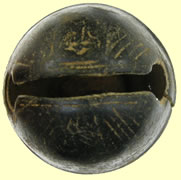 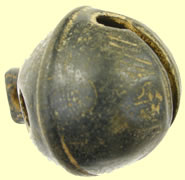 |
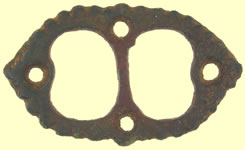 |
||
17thC crotal bell with foundary mark |
1550-1650 buckle |
||
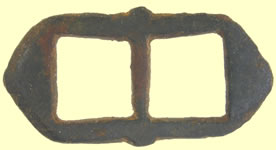 |
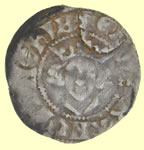  |
||
1550-1650 buckle |
1279 Edward 1st hammered silver penny - type 10cf Obv EDWAR R ANGL DNS HYB Obv VILLA/SCIE/DMV/NDI - Bury St Edmunds mint |
||
  |
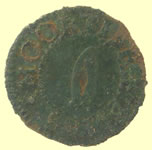 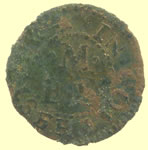 |
||
Medieval hammered long cross silver penny |
17thC , Elias Mootier of Colchester Essex hammered copper trade farthing Norweb Fig 1208 Part II |
||
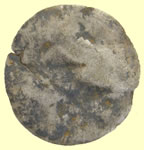 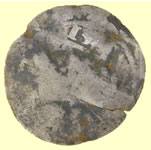 |
|
||
Mediival Irish hammered silver penny |
Georgian spur |
||
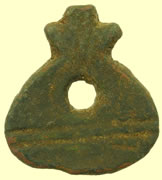 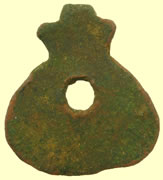 |
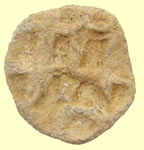 |
 |
|
Interesting decorated mount - not sure of it's date |
Saxon lead token |
20thC girl guides badge |
|
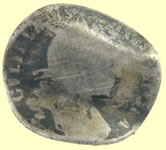 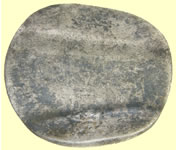 |
 |
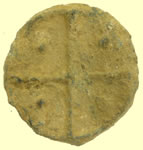 |
|
1696 William III milled silver love token |
Georgian watch winder |
15thC lead token - long cross and pellet type 2 |
|
 |
 |
|
|
Interesting decorated widget ? |
Rare find 19thC Ipswich Loyal Volunteers army button |
Medieval seal matrix Anonymous: letter I early 15thC. An initial with crown above, branches at the side, was a design that became increasingly common in the 15thC and was often used on a signet ring as below. The letter suggests it stood for the owners forename. This example was used in 1424 by Edward Saddler, clerk |
|
  |
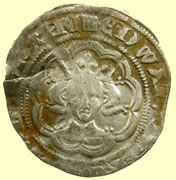 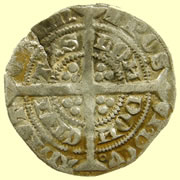 |
||
Tiny 1279 Edward 1st hammered sterling silver farthing - new issue with inner circles both sides Type 28 Obv EDWARDVS REX Rev CIVI/TS/LON/DON - London mint 11.37mm, 0.17g |
1351-2 Edward III hammered silver half groat - 4th coinage Series C Obv EDWARDUS REX FRANC Rev CIVI/TS/LON/DON - London mint 21.71mm, 2.29g |
||
 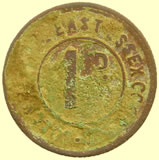 |
 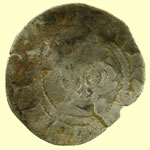 |
||
20thC Colchester & Essex Co -op society 1 pence token |
1341 Edward III hammered silver florin penny Obv EDWR ANGL DNS HYB Rev CIVI/TS/LON/DON - London mint |
||
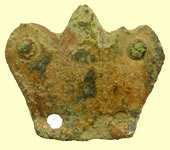 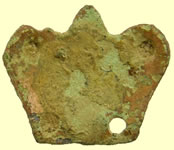 |
|
||
Medieval gilded mount - 4 rivet fixings |
Medieval buckle with integral plate - some gilding remains - 2 rivet fixing |
||
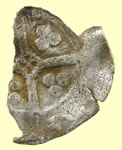 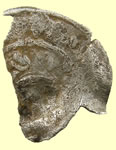 |
 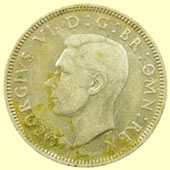 |
||
Medieval hammered silver penny - York Archbishop issue - Quatrefoil with pellet at centre of reverse cross - CIVI/TAS issue |
1945 George VI milled silver shilling (12 pence) |
||
 |
|||
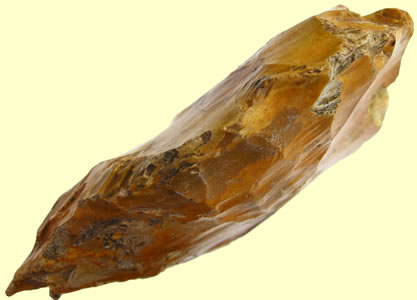
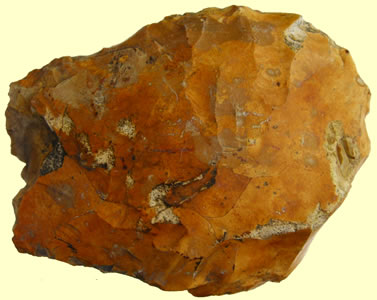



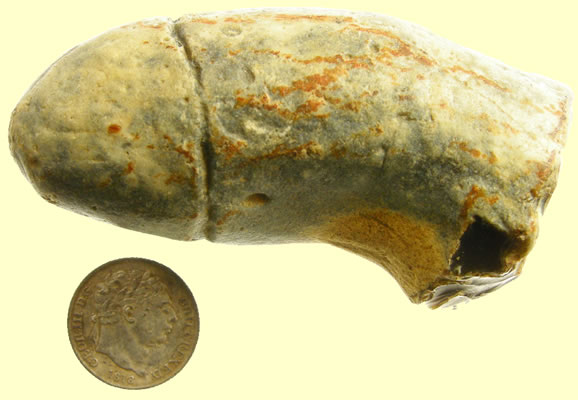
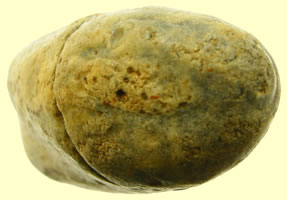
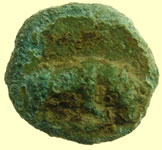
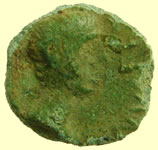
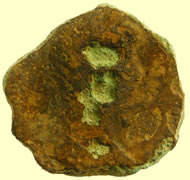
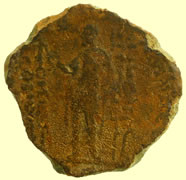

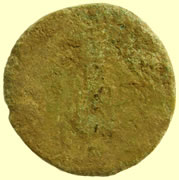
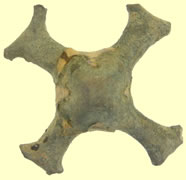

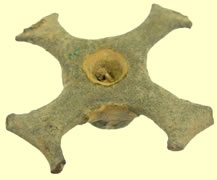
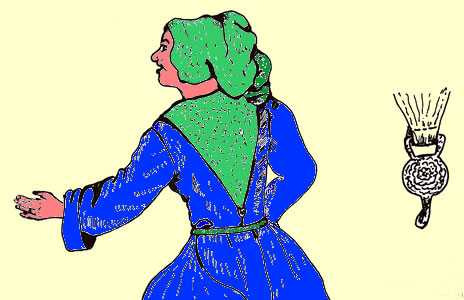
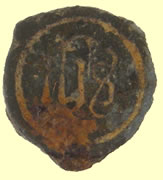 i
i